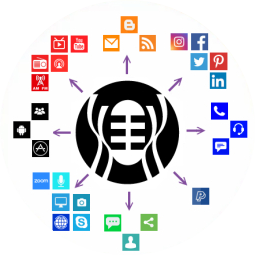I am having a guest on my radio show that will be speaking about Empowerment of Women and I began to wonder what women can do to get on the empowerment train and stay there. Also, what does empowerment look like to todayâs woman and where do we go to find it. Men should listen in to help all the wonderful women in their life.
Are Women of 2015 Actually Empowered?
I am having a guest on my radio show that will be speaking to this very topic and I began to wonder what women can do to get on the empowerment train and stay there. Also, what does empowerment look like to today’s woman and where do we go to find it. First some stats about women in America.
The US government has some very interesting data. The following is some information from Women in America: Indicators of Social and Economic Well-Being as well as Thinkprogress (dot org)
People, Families and Income:
- Women are marrying later and have fewer children than in the past. A greater proportion of both women and men have never married, and women are giving birth to their first child at older ages.
- Although more adult women live in married-couple families than in any other living arrangement, an ever-growing number of women are raising children without a spouse.
- More women are remaining childless, although eight out of ten adult women have children.
- As the baby boom generation ages, a growing share of women – and men – are older. Because women live longer, women continue to outnumber men at older ages.
- Women are more likely to live in poverty than are adult men. Single-mother families face particularly high poverty rates, often because of the lower wages earned by women in these families.
From Thinkprogress.org:
18: Average percentage by which women worldwide are paid less than their male counterparts at work.
0.77: The female-to-male earnings ratio in the U.S., meaning female workers earned 77 cents on every dollar earned by a male worker. Progress on the pay gap in the last 10 years remains statiscally unchanged.
Education:
- Women’s gains in educational attainment have significantly outpaced those of men over the last 40 years. Today, younger women are more likely to graduate from college than are men and are more likely to hold a graduate school degree. Higher percentages of women than men have at least a high school education, and higher percentages of women than men participate in adult education.
- Educational gains among women relative to men can be seen across racial and ethnic groups and this trend is also present in other developed countries.
- Despite these gains in graduation rates, differences remain in the relative performance of female and male students at younger ages, with girls scoring higher than boys on reading assessments and lower on math assessments.
- These differences can be seen in the fields that women pursue in college; female students are less well represented than men in science and technology-related fields, which typically lead to higher paying occupations.
58: The percentage of all undergraduate degrees in the U.S. that were awarded to women in 2010.
Employment:
- The participation of women in the workforce rose dramatically through the mid-1990s, but has been relatively constant since then.
- Workforce participation among men has declined, but women are still less likely to work in the paid labor force than are men. When women do work, they are much more likely than men to work part-time.
- Women continue to spend more of their time in household activities or caring for other family members; they also do more unpaid volunteer work than men.
- Despite their gains in labor market experience and in education, women still earn less than men.
- In part, this is because women and men work in different occupations, with women still concentrated in lower-paying and traditionally female occupations.
- Because women earn less and because two-earner households have higher earnings, families headed by women have far less income than do married-couple families.
From Thinkprogress.org
64: The percentage of mothers with children under the age of 6 that are in the labor force. 78 percent of mothers with children ages 6-17 were in the labor force.
12: Number of Fortune 500 companies that have female CEOs.
1.9 million: Number of firms that are majority-owned (51% or more) by women of color in the U.S.
26: The percentage of vice presidents and senior executives that are female.
7: The percentage of directors on the world’s coporate boards who are female.
Health:
- Life expectancy has increased over time for both women and men; however, women continue to live longer than men.
- Women are disproportionately more likely than men to be affected by certain critical health problems, including mobility impairments, chronic health conditions such as asthma, arthritis, or depression. Women are less likely to be physically active and are more likely to be obese. Females age 12 and older are more likely than males to report experiencing depression.
- Women continue to have a lower incidence of heart disease than men and are less likely than men to suffer from diabetes.
- Women generally use the health care system and preventive care more than men, but many women still do not receive recommended preventive care such as pap smears or flu vaccinations.
- The share of both adult women and men without health insurance has increased over time. People with insurance are much more likely to have a doctor or other medical professional who provides regular care; one out of seven women have no usual source of health care.
Crime and Violence:
- Women are less likely than men to be victims of crime. As overall crime rates have fallen in the United States, the likelihood of victimization has declined.
- The probability of being a victim of a violent crime (assault, robbery, or homicide) has declined among both men and women in the last two decades.
- Attacks on women by their intimate partners have fallen since the passage of the Violence Against Women Act in 1994, although women are still much more likely to be victimized and injured by this type of violence than are men.
So it seems we females are certainly being educated, spend lots of time in the workforce and in the household working and are still being paid less than men. Women’s representation as high-level execs is still also on the low side. The good news is that small business is a major part of the US economy and women are growing into entrepreneurs and have the education and skills to do so. Women are marrying later in life and the number of women choosing not to have children is rising. It makes sense if we are in college and running our businesses, mommy time may be on hold, or not happen at all.
Since we will be living longer than men typically, we have the opportunities and quite frankly, the need to be able to sustain ourselves into our very late years. This means attaining enough funds to make it to the end of our lifetimes. Women bring lots to the table naturally including a keen sense of intuition, concern for others and are great at relationship building and collaborating which is the key to any thriving business, according to Forbes 4 Skills that Give Women a Sustainable Advantage Over Men and itbusinessedge.com- Womens Strengths and the Value They Bring to the Corporate Table
It’s time all women start bringing their natural gifts and learned skills out to the world. It’s time to use our interests and passions to fulfill our work. A well balanced woman ( any human being) needs mind, body and spirit fulfillment and there are a number of unique ways to do that. Empowerment Expert Lisa Marie Jenkins will be discussing this on our Nov. 9th show. Men, listen in too for your wives, girlfriends, daughters, mom and any other important women in your life.
Lori Peters
Check out my radio show for more on the empowerment of women with guest Lisa Marie Jenkins at BBS Radio Wednesday, Nov. 4th at 8pm Eastern, 5pm Pacific.
Lori Peters is the creator of Happiness Hangout which provides resources, activities and professional speaking services in the area of happiness and well-being. She has her own radio show called Happiness Hangout.









